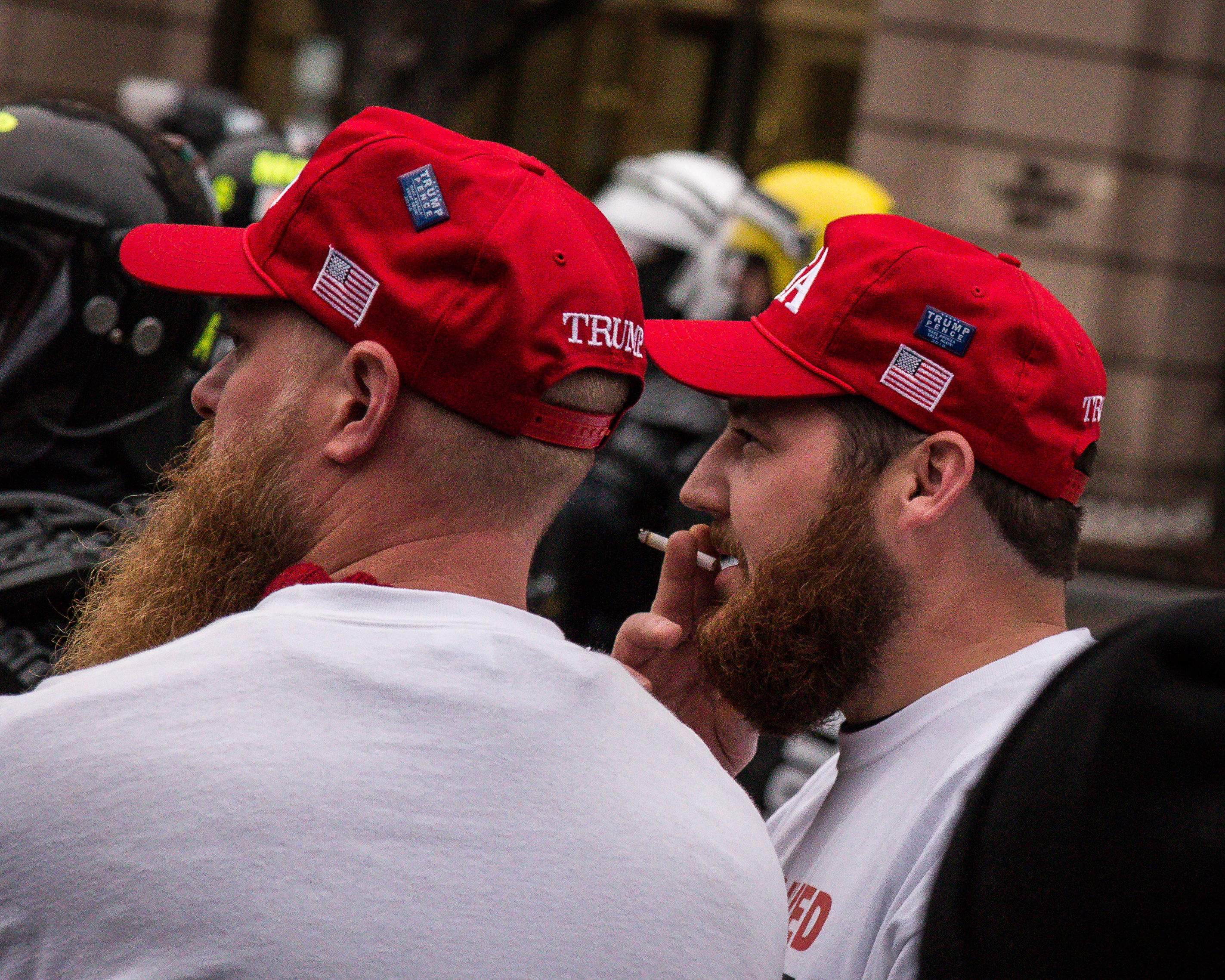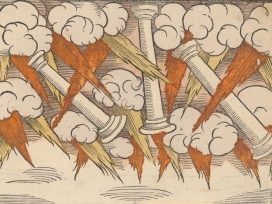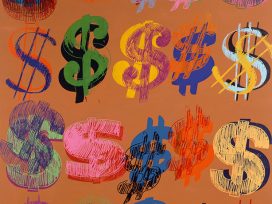The United States is currently embarked upon the most aberrational presidency in the history of the republic. Plenty of past American presidents have done things that sparked off international protests, but no president has ever before provoked mass demonstrations in his own country and more than sixty others simply for taking the oath of office.
The moral force of these protestors relies partly on the assurance that most Americans do not support Donald J. Trump, who won despite losing the popular vote by a margin of nearly three million. And the missing mandate rankles – hence Trump’s repeated, baseless claims of voter fraud, dovetailed with his anti-immigrant messaging that millions of ‘illegals’ voted against him.
But Donald Trump is not really interested in electoral arithmetic, more with projecting himself as a winner, the all-time winner. He appeals directly, not to ‘the people’ as the sovereign power in a representative democracy, but to people as an audience of fans. His favourite mode of political interaction is the rally, a stage-managed event in front of a crowd of supporters. After the election, Trump embarked on a ‘thank you’ tour of self-congratulation, and even since his inauguration he has returned to his comfort zone of stadium show stumping.
This particular form of unpresidential behaviour is generally explained in psychological terms – something Trump needs to fill the bottomless pit of his ego. Perhaps this is true, but it misses the larger political point. This was precisely the playbook that won Trump the Republican presidential nomination because it broke all the rules of campaign fundraising and politicking. Trump turned his run into a prime-time pop spectacle and gained all the media attention he needed – for free. For many heartland Republican voters, it was enough that he was promising to restore greatness and that he looked like a winner.

Trump supporters watch anti-Trump protesters January 2017. Image: Mobilus In Mobili, Wikimedia
It’s easy to lose count of the ways Trump’s election win turned conventional wisdom on its head: the polls were wrong, the party elite was overthrown, the traditional policy platform was torn up, endorsements didn’t matter, disqualifying behaviour and comments were not disqualifying at all, traditional disclosures like medical records and tax returns were denied, demagoguery was an asset not a liability, and so on.
Again, all true. But these are the epiphenomena of the one truly important fact: 2016 was the year that a populist won the presidency. With the possible exception of Andrew Jackson – nicknamed ‘King Mob’ by his opponents – in the early nineteenth century, no such rabble-rouser has ever before attained the White House. (The comparison is not lost on Trump, who has hung a portrait of Jackson behind his desk in the Oval Office.) This makes Donald Trump the apogee of a distinctively American type: the reactionary populist.
Populism and hucksterism
Populism in the US derives from the People’s Party that formed in 1891. Also called the Populist Party, it began as an agrarian movement rooted in the anger of Midwestern farmers and Southern sharecroppers at what they saw as exploitation by Eastern elites – price-fixing and overcharging by banks and railroad companies. It was radical in its economic demands, calling for an end to the monopolies and greed of the robber-baron capitalism of the Gilded Age. But, although the Populists did make some alliances with labour organisations that shared their redistributionist agenda, they largely retained the social conservatism of their agrarian origins.
The Populists swiftly became a national force in politics thanks to the Panic of 1893, a serious depression caused by a collapse of railroad stock speculation and series of bank failures. Unemployment shot up from below 4 per cent in 1892 to a peak of 18 per cent in 1894, and it was five years before the recovery came.
But the Populist Party’s initial success was short-lived for a number of reasons. The Democratic Party adopted parts of its programme, and in some areas the two parties formed a ‘fusion’ electoral coalition. In the South, though, Populists allied with Republicans against the segregationist Democrats’ dominance of Dixieland. (The Republican Party took over the South from the Democratic machine only after the Civil Rights legislation of the Johnson administration in the 1960s forced segregationists to switch sides – a historic shift that empowered Richard Nixon’s Southern strategy and broke with the party’s inheritance from Abraham Lincoln.)
The contradictions of that split in Populist alliance-building helped doom the party, but it was also discredited by its own reactionary tendencies. Populism undoubtedly included progressive elements – some former Populist activists ended up in Eugene V. Debs’s Socialist Party – but it was also driven in part by a belief that the Little Man had been cheated by a conspiracy of Eastern elites and Jewish financiers. Despite some similarities of fiery rhetorical style, these anti-modern and nativist tendencies of Populism marked it out as very different from the international socialist currents among industrial workers. Yet it is prairie populism that has the abiding influence in American politics – thanks in large part to the successful repression of socialism in the United States.
Working-class militancy was crushed ruthlessly in the late nineteenth and early twentieth centuries – first by the private armies of strikebreakers and Pinkertons of the robber barons, and later by the ‘Red Scare’ tactics of the Wilson administration. The Iron Heel, Jack London’s 1908 novel, was a work of dystopian fantasy, but its vision of the Oligarchy beating down organised labour with billy clubs and rifle butts did not need much imagination. That is what happened, more or less. And while most Populists probably opposed America’s entry into the First World War, only socialists spoke up about it. The government’s response was the Sedition Act of 1918, which resulted in Eugene Debs running for president in 1920 from a prison cell. Earlier that year, the anarchist Emma Goldman was rounded up in the Palmer Raids and deported along with hundreds of others, a campaign that helped to establish the idea that socialism was literally alien, an un-American ideology of immigrant troublemakers.
The objective for the governing duopoly of Republicans and Democrats was to keep America safe for capitalism, by snuffing out the threat of socialism while absorbing Populism’s radical economic demands. Hence the reform-minded liberalism of the Progressive Era which saw the Republican president Theodore Roosevelt’s ‘Square Deal’, and the anti-trust laws of the Progressive Era that finally broke up the industrial monopolies of America’s Gilded Age plutocrats – whom Roosevelt, no shoeless pauper himself, called the ‘malefactors of great wealth’.
To win support for the New Deal, his response to the economic and social misery of the Depression, Teddy’s Democratic nephew, Franklin Delano Roosevelt, also borrowed from the populist playbook – promising to ‘equalise the distribution of wealth’, if necessary by throwing ‘to the wolves the forty-six men who are reported to have incomes in excess of one million dollars a year’. The early New Deal years also brought brief respite from repression for American socialism: by the end of the 1930s, the Communist Party had reached its peak membership of about 80,000–90,000. (The reprieve was short-lived: the House Committee on Un-American Activities, best-known for its association with the post-war witch-hunts of Senator Joseph McCarthy, opened for business as early as 1938.)
The reason for Roosevelt’s reforming zeal was that, far more than any threat from socialism, he feared populism’s reactionary energy, specifically in the form of a Louisiana senator named Huey Long. In 1932, Roosevelt described Long as ‘one of the two most dangerous men in America’ (the other being the then fascist-leaning General Douglas MacArthur). At the time, Long’s programme looked a lot like the radical redistributionism of the left: he wanted tax reform that would have capped earnings above $1 million a year with a 100 per cent tax rate. Roosevelt privately admitted that the New Deal was, in part, an effort to ‘steal Long’s thunder’; FDR’s 1935 Revenue Act, known popularly as the ‘Soak the Rich’ tax, increased the top rate of income tax to 79 per cent (for most of his predecessor Herbert Hoover’s term, that rate had been 25 per cent).
The economic populism of Long’s ‘Share Our Wealth’ movement (slogan: ‘Every Man a King’) had deep roots in the South of poor white share-croppers but also appealed to the agrarian reform tradition among Midwest farmers; and it was allied to a profound social conservatism. Long made common cause with Father Coughlin, a rabble-rousing Catholic priest who preached something close to fascism. Both were astute and effective users of the new mass medium of radio. Coughlin built a national following of 40 million listeners, the largest radio audience in the world at that time.
It is sobering today, in light of Trump’s reflexively authoritarian tendencies, to understand just how disturbed Roosevelt was by the populist threat to American democracy in the 1930s. ‘Long plans to be a candidate of the Hitler type for the presidency in 1936’, he confided to an ambassador friend. He feared that Long would purposely split the Democratic vote, enabling the election of an inept Republican who ‘would bring the country to such a state by 1940 that Long thinks he would be made dictator’. In the event, Long was assassinated in Baton Rouge in 1935, while Coughlin’s hastily convened Union Party proved an embarrassing flop in the 1936 election.
Still, Long’s invective against Wall Street fat cats and his promise to champion the ‘forgotten men’ against the elite ‘team’ who ran things in Washington cast a long shadow. Last year, as a Trump victory seemed not impossible, it became commonplace to read references to Sinclair Lewis’s 1935 novel It Can’t Happen Here, and the stage adaptation was also revived. Like another novel of 1935, Robert Penn Warren’s All the King’s Men, its protagonist was clearly modelled on Long, a demagogue swept to power by promising to restore the country to prosperity and greatness.
In It Can’t Happen Here, Senator Buzz Windrip wins the 1936 presidential election, and quickly turns to brutal authoritarian rule. Opponents flee to Canada, before rallying a resistance movement that leads to civil war. Ultimately, Windrip is deposed in a military coup. Lewis’s somewhat didactic warning is not to ‘let the demagogues wriggle in, without fierce enough protest’.
The power of the demagogue was a theme revisited by Elia Kazan in his 1957 film A Face in the Crowd. But it is less the spectre of fascism that haunts the movie than America’s susceptibility to a populist antihero. The film’s protagonist Larry ‘Lonesome’ Rhodes is a charismatic drifter whose singing talent and folksy egalitarianism bring him fame and influence as a TV entertainer – until he is undone when the disillusioned producer of his show leaves the microphone on during the credits, so that his millions of fans hear themselves mocked as ‘idiots, morons and guinea pigs’.
Trump, too, is often called a huckster – and this is not just a question of name-calling. Conmen have been feature of American culture at least since the showman P.T. Barnum, the ‘Prince of Humbugs’ who gained a reputation as a liberal reformer for what he called ‘profitable philanthropy’. Mark Twain immortalised the type in The Adventures of Huckleberry Finn with the duke and the king, a pair of itinerant grifters who swindled simple townsfolk with their pseudo-Shakespearean theatrics and schemes. Herman Melville’s last novel, The Confidence-Man, shared the Twainian locale of a Mississippi riverboat, on which virtually every passenger is engaged in some nefarious scam or other.
The political version of this charlatan, one who masquerades as the champion of the working man and ordinary folks for venal, self-seeking ends, is an authentic and abiding American type. In Trump’s trademark scowl – narrowed eyes, middle-distance stare, chin-forward pout – it is hard to see anything other than the poker face of assumed seriousness that is the mask of every carny barker, tent-revival preacher and snake-oil salesman America has ever seen.
The suppression of socialism, effectively outlawed a century ago, left a floating constituency susceptible to such false prophets with their phony radicalism. At critical moments in United States history, when people feel down on their luck and capitalism seems unable to save itself, into this ideological vacuum flows American populism, a confusing mishmash of left-wing economics and right-wing social values. The negative dialectic of American politics is that collectivism only finds expression in this reactionary form: it appears in the shape of a self-invented messiah, who assumes the mantle of an anti-system reformer, uses mass communications to short-circuit democracy, and sees no problem with mingling business and politics to personal advantage.
Today, that person is the real-estate mogul and reality TV personality Donald Trump. But what is specifically Trumpian about Trump’s reactionary populism?
Right-wing Leninism
It would be easy to dismiss Trump’s bumper-sticker slogans – ‘America First’, ‘Buy American’, ‘Make America Great Again’ – as the crude and inchoate demagoguery of an empty vessel. But Trumpism is quickly assuming shape and coherence in power. It is taking the form of a crony-capitalist corporatism that combines anti-immigrant welfare chauvinism with economic protectionism and an isolationist foreign policy. The vision belongs to Trump’s chief strategist, former Breitbart News chairman and now senior White House adviser Stephen Bannon.
In a 2014 speech, Bannon predicted a ‘global revolt’ that would be a ‘centre-right populist movement of really the middle class, the working men and women in the world who are just tired of being dictated to by what we call the party of Davos’. The extent to which this political project has stolen the clothes of social democracy in Europe and New Deal corporatism in America was highlighted when Bannon recently noted that ‘The beginning of all this was the anti-globalisation movement’.
A self-styled Leninist, Bannon initially regarded Trump as ‘a blunt instrument’ for his radical remaking of the American right. But it turns out that this Svengali has found his perfect agent of change.
Bannon’s grip means that the White House inner circle appears to be operating under a system of dual power: one side is constituted by conservative career politicians like Vice President Mike Pence and Republican National Committee chairman Reince Priebus, while a rival group is made up of Trump loyalists, Bannon confederates like Stephen Miller and Michael Anton.
A revived Christian nationalism is what unites Pence and Bannon. ‘When fascism comes to America’, runs the dictum often attributed to Sinclair Lewis, ‘it will be wrapped in the flag and carrying a cross’.
For Pence, this is a matter of convictions. For Bannon, it is more Machiavellian and strategic. Their common cause is to craft an agenda of social conservatism that will create ‘values’ wedge issues, such as transgender rights, abortion provision, and religious education in public schools. For Pence, the Trump presidency is a heaven-sent opportunity to take back the country from godless secularists and liberals, as well as the multicultural hordes of metropolitan America. For Bannon, the aim is to create chaos, sow discord and provoke protest – to attack the progressive coalition on so many fronts that it will split into constituent elements that can each be isolated. It is a deliberately engineered system of disruption designed to neutralise opposition.
No very paranoid imagination is needed to see that, however things shake out, Trump-world is shaping up to be probably the most right-wing American government since the Confederacy. Even if the Republican Party, through its control of Congress, succeeds in keeping this administration semi-‘normal’ and preserving democratic institutions, we can expect an erosion of checks and balances. There has been a sharp rightward shift in the ‘Overton Window’ – the idea that there is an unspoken consensus about what, at any given time, are the acceptable norms of political discourse. Trump’s attacks on ‘political correctness’ were a dog-whistle to all forms of ‘out-grouping’: nationalism, anti-immigrant sentiments, Islamophobia and white identity politics have all been given permission and empowered. With the Overton Window wide open, the ideological storm troopers of the so-called alt-right have emerged from the dark web to become public figures.
Already, the president has made reckless use of executive orders, ordering a start to his wall on the border with Mexico, a military build-up, the travel ban on Syrian refugees and Muslims from seven countries, and dragnet enforcement measures against the estimated 11 million undocumented immigrants. And he continues to flirt with the idea of restoring the Bush administration’s torture programme.
Meanwhile, he is assembling a new oligarchy of the uber-rich, with a cabinet so thick with plutocrats that, according to CBS, just seven of them alone have a combined net worth of $11 billion, while counting the wealth of all the nominations to date provides a total at least $14 billion. The notion that this team can restore American middle-class prosperity through a zombie version of trickle-down Reagonomics is obviously delusional. It is possible that Trump may fight his own party to maintain campaign promises to protect Social Security and Medicare (programmes popular with most blue-collar Republican voters), but his proposed tax cuts will inevitably amount to a colossally regressive redistribution.
The press has been under attack from day one, with the demonisation of fact-based journalism, the assertion of fantastic lies (‘alternative facts’), and the constant attacks on the ‘lying’ and ‘dishonest’ media. Its role as a check to power has seen it labelled ‘the opposition party’ by Bannon and ‘the enemy of the American people’ by Trump.
In the United States the three branches of government (executive, legislative and judicial) are intended to act as checks and balances, but with both Houses of Congress under Republican control, constitutional resistance to untrammelled executive action rests solely with the judiciary – and the media. To the extent that the fourth estate holds power accountable in a liberal democracy, alongside the three branches of government, the White House has drawn the battle-lines. (And Trump also got a head start with an ad hominem attack on a judge during the campaign; while as president he has shown a similar lack of restraint in attacking any court decision he doesn’t like.)
This more sinister element of authoritarian and antidemocratic rule may stay suppressed or could emerge as the dominant theme. Trump already displays many of the gestures of the strongman, particularly in his insistence on making the observable facts of reality conform to whatever he wills to be true. The hyped threat of ‘radical Islamic terror’ may represent not just the phobic othering of a Christian nationalist mind-set but the ideological preparatory work for a strategic goal. Already, a draft memo reportedly circulating in the White House has proposed federalising the National Guard to help with immigration enforcement. It is not a stretch to imagine that the crusader rhetoric of Bannon’s associates, in combination with actual anti-Muslim measures such as the travel ban, could inspire a terrorist outrage by radicals claiming allegiance to the Islamic State. Having thus engineered a domestic emergency attributed to a foreign terror threat, the president could use his executive authority to militarise law enforcement under federal control, enact a stealth suspension of constitutional government, and begin to rule by decree – a word he used in his inauguration address.
It can’t happen here? Enough informed and rational people are losing sleep over the prospect of Bonapartism in twenty-first-century America that it demands to be taken seriously.
We are not there yet. But h ow best to resist is a question daily confronting the broad, but as yet unformed opposition.
Defending democracy
Whatever its manifest flaws, American democracy – government of the people, by the people, for the people – is still a bedrock value in the United States. As long as democratic institutions endure, so will this ideal of a citizenry pledged to defend a republic founded on the Constitution and the Bill of Rights. Anything else is un-American.
But in the battle of ideas, war has been declared on the concept of what is and isn’t American. In Trumpian populism we are seeing an effort to redefine it, away from republican values and toward something much more volk-ish.
The Constitution has itself long been a political battleground, but mainly for the conservative right, for whom it has been a fetish object – especially for ‘originalist’ interpreters. Thus, in his critical opinion in a 2008 Supreme Court ruling, the late Justice Antonin Scalia’s literal interpretation of the Second Amendment right to bear arms was used as a means to justify individual citizens’ owning whole armouries of semi-automatic weapons. Liberal Democrats, on the other hand, have tended to see legislation, not litigation, as the way to secure social change. In recent years, it has often been only a minority on the libertarian left – with a special interest in issues like government surveillance – that has seen constitutional protections against warrantless search and seizure as a useful political tool.
There are signs now, however, that progressives are rapidly rethinking the value of rights-based claims in the courts as a shield against the forces of reaction. In a single weekend, after Trump’s executive order cutting refugee quotas and suspending admissions from Muslim-majority countries, the American Civil Liberties Union received more than $24 million in donations (more than five times its normal annual total); and the group has also seen a nearly 50 per cent surge in membership. Advocacy groups and rights defenders such as the Anti-Defamation League, the Center for Constitutional Rights, the Southern Poverty Law Center and a host of others have seen a similar ‘Trump bump’.
There were also spontaneous protests of hundreds and thousands at airport terminals as people rallied to defend citizens and visa holders suddenly detained amid the chaos of the executive order’s implementation.
Clearly, many Americans understand that, with two branches of federal government locked down, only action in the third branch, the judiciary, remains as a check. Constitutional arguments in the courts are becoming a key front for mobilising opposition. A combination of ‘lawfare’ by nonprofits and campaign groups and targeted, well-organised protests has already evolved as the first line of resistance. And protest matters here, because judges do not make decisions in a vacuum: loudly voiced popular support helps protect judicial independence.
However, the window of opportunity for the opposition to unite and form a popular front of liberal constitutionalism remains open only for as long as the rule of law and the separation of powers continue, which is by no means an eternal given. The strength of a movement built on defending rights is that it can lay claim to the patriotic language of American liberties. On this terrain, the lawfare strategy can reach ‘across the aisle’ and find willing and natural allies among traditional Republicans, as well as Trump-averse moderates and independents.
The weakness of a movement built on defending rights, however, is that it is by definition defensive. The anti-Trump resistance cannot wait for individual cases brought by the new army of ACLU lawyers to wind their way up through the courts to become causes for national rallies. It will need to occupy the street and the public square on its own schedule, and define a broader programme of social justice than merely the formalist one of civil rights.
The opposition must also anticipate well-aimed efforts to split its resistance. The tradition of disciplined civil disobedience in the United States is long and powerful, and that wellspring has risen again with the Black Lives Matter movement and the Native American protests at Standing Rock. But activists will be tested when people willing to put their bodies on the line actually get hurt. And it will not take many windows broken by black bloc protesters, or reports of shots fired at police, for protests to lose their moral authority.
The violence instigated by a minority of demonstrators protesting the invitation of Breitbart provocateur Milo Yiannopoulos to speak on the campus of the University of California, Berkeley, was a foretaste of potentially ruinous wrong turns. The anti-fascist slogan of ‘no platform’ for racists and fascists goes against the prevailing norms of First Amendment freedoms. Left-wing activists will need to argue the case for free-speech exceptions and target their efforts better if they want to avoid losing the high ground of American values and splitting the opposition against Trump surrogates.
These are all concerns, but the greatest weakness of a street protest movement built on defending rights is that it will not speak to the forgotten men and women of America. We are in this mess of populist revolt precisely because the neoliberal consensus that saved the economy from collapse in a financial crisis failed utterly to address underlying economic inequities and inequality. Worse, it allowed the recovery to resume a trajectory of regressive redistribution.
Facing crises of popular discontent created by unsustainable economic injustice, both Presidents Roosevelt saw that American capitalism could only be preserved by heading off a populist threat that was likely to pitchfork not just the rich and the elites, but the democratic system itself. Only urgent reform and a radical redistribution of the nation’s wealth would stop a dangerous demagogue from taking charge of America’s surplus army of the disinherited and resentful.
This is very different from the Obama strategy. President Obama took over a bailout plan that had been designed by his predecessor George W. Bush and a Republican-controlled Congress. This rescue programme for Wall Street may have prevented the economy from collapsing, but it did little to create jobs or avoid foreclosures on Main Street, let alone to alleviate the economic pain caused by longer-term trends of automation and globalisation. Fixing health care was a worthy aim – the great missing plank in America’s welfare state that neither FDR’s New Deal nor Lyndon Johnson’s Great Society had nailed down – but it was a project for a time of large prosperity, not a period of desperate austerity. As good a president as Obama was, his decision to make the ultimate technocratic challenge his signature legislation involved passing up a generational opportunity to soak the rich and stop the pauperisation of the middle class. It was a ‘party of Davos’ choice, and, for all its ambition, a political error with epochal consequences.
A few weeks before his death in 1968, Martin Luther King Jr. spoke of ‘the other America’. ‘This country has socialism for the rich’, he said, ‘rugged individualism for the poor’.
Today, it is King’s message of economic justice that must find new advocates in party politics. Donald Trump has succeeded in articulating the legitimate sense of grievance of a great struggling class of people to a deeply reactionary identity politics, by drawing on their folkloric sense of the American dream as their lost birthright. If the United States is to survive this outbreak of the virus of populism – the most dangerous in its history – the Trump resistance must find ways to detach white nationalism from Trumpism’s false promise of economic justice.
Besides reclaiming the right to speak for the other America, the grass-roots protest will have to migrate from the streets to bring about a democratic renewal in the chambers of capitols across the United States. The challenge for the Elizabeth Warren wing of the Democratic Party is to break out of its narrow lane of partisan progressive politics and begin to build a broad electoral front.
The forgotten men and women, bitterly accustomed to disappointment, are always ready to ‘throw the bums out’. But Americans need to be offered a better deal.







